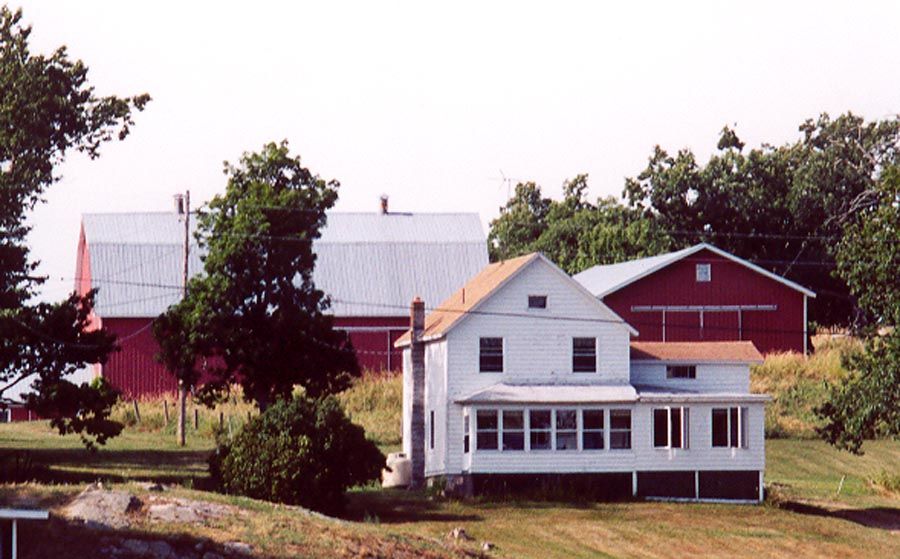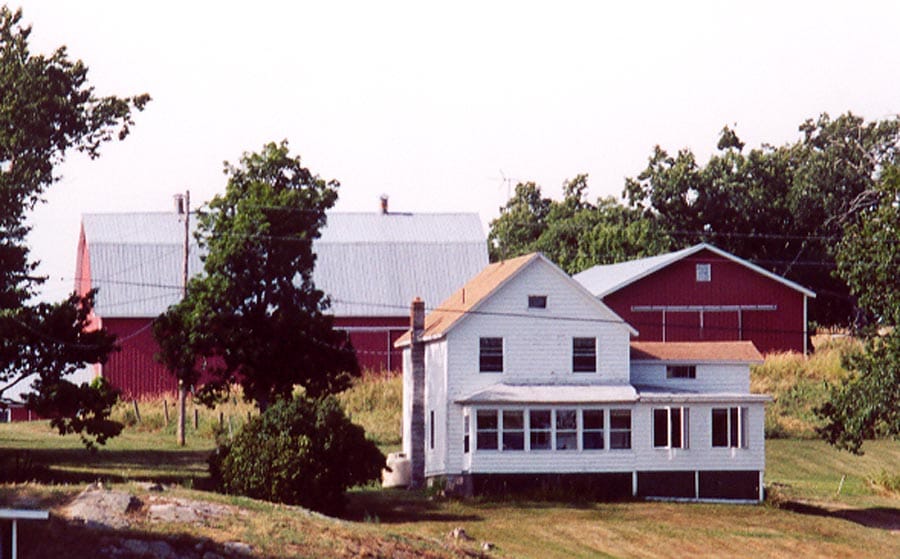The Old Farmhouse
by: Manley L. Rusho
Grindstone Island: circa 1930’s – early 1940’s
In the old farmhouse where I lived as a child, my bedroom was at the top of the stairs. A quick turn left and you entered a small bedroom with a window facing north – due north. Even though my bedroom window did not face the River, it still had a wonderful view of the farm itself.
The old woodshed had weathered, dark brown wood siding, and was slowly sinking into the ground. The dear old thing was probably built during the civil war era. The vertical wood siding was built on a frame with no studs and a flat roof that sloped towards the west. The western outer wall boards rested against a large granite rock. The other three sides were being consumed by the soil they rested on. The side facing my room was solid wood, no window or door, only on the east was there an oversized entrance with no door, just an opening.
On the south side of the old building was some very fertile black soil that from May until frost time, my mother always had planted an array of flowers. Tall sunflowers and marigolds grew along with a vine with blue flowers that embraced the entire shed wall. The little flower garden was a thing of beauty. When autumn came, my mother would harvest the seeds to use in next year’s planting. Many of the sunflower seeds were left out for the birds to enjoy.

Between the house and the shed was a patch of grass that was mostly a carpet of dandelions so bright, big, and so yellow. East of the building was the gravel road that led to the barn and on the other side of the road was a great raspberry patch. To the north was a large potato garden and the great Red Barn.
Northwestward was the chicken house, in clear sight from my bedroom window. It was a long building, with all of the windows facing south. The yard in front of the building was enclosed with a high fence about 10 feet tall that separated the yard into two enclosures. The chicken coop enclosure was built and framed out of boards with the bottom of the fence having chicken wire nailed to the boards. It was designed to keep the chickens in and intruders out. Beyond the chicken coop was a small wood coop and a solid rock formation that was coal black.
A very large hickory tree grew along the eastern edge of the fence. A small outhouse or privy was located about 6 feet to the right of the hickory tree. It was the traditional two-hole seater and was rotted away. The rear wall near the bottom was open to the elements, but the roof was intact. The door was now secured only by a bottom hinge, hung at an angle. We were quite modern, as we had a flush toilet in our basement and no longer needed the privy.
Throughout the summer, I watched the potatoes grow to rather large bushes, with lush green plants in rows hoed and weeded – they would become our winter’s food supply. Across the road from the barn was a sweet corn field and another hickory tree that dominated the field. By mid-summer, the stalks produced fresh corn that we sold to the summer people and kept enough for our winter food supply.
July was dominated by the haying season, great loads of loose hay piled high on the wagons. The wagons would be pulled into the barn and the hay lifted by a huge fork and trolly into the hay mow, where it was carefully stored by hand, providing food for the cows and horses.
With August, there were apples to harvest. We had no apple trees that produced an edible crop, but our neighbors did, and we were allowed to pick those apples and use them for food.

The baby chicks that had been ordered and arrived by rail in Clayton early in the spring were now full grown. About half of our chickens – about 75 of them – would be killed, plucked, cooked, and canned in the pressure cooker. They were stored in the cellar to await a winter meal. The potato plants were now a dirty brown color and ready for harvesting. The surplus corn was picked, shucked, peeled, and canned. To my mother, the cans in the cellar were bragging rights, just like a treasure.
Come October, the hickory trees were bare, mere sticks with a few stubborn nuts clinging to leafless twigs. The ground beneath was covered with empty husks, since the squirrels harvested most of the nuts for the coming winter and winter was coming.
The tomatoes were all canned and in the cellar with the other harvest treasures and the field they grew in was now a muddy mess, until a freeze. The cornfield, with its harvest gone, contained some leftover corn stalks, most of them laying on the ground but with still some left standing erect. The stalks still attracted small flocks of birds, like the blackbirds that whirled around like aerial artists in almost a solid group, as they prepared for their flight to warmer places.
The winter birds arrived – chickadees, sparrows, and the great noisy blue jays, whose cries announced their presence. Gone now were the robins, whose nests still remained firmly attached to the inside of the old privy, and another nest stuck to the upper windowsill of the shed. The winter birds feasted on the chunks of suet that my mother attached to the south wall of the shed for them.
November brought the wood cutting; large logs were dragged from the nearby wood, cut, and stacked into a pile as large as the shed. My Uncle Rawdon (Dano) had a saw, a buzzsaw that he powered by the battery in his car. It was a large circular saw that would cut the log into stove-sized chunks. Much of the wood would be split for the cook stove in the kitchen, with the larger chunks used as heat in the round oak stove in the living room.
In December, January, and February, there was no real activity, except an occasional visit from an owl in one of the hickory trees. As the wood pile started to diminish, the path through the snow to the barn grew deeper.
March brought the constant dripping of melting ice from the eaves, and the southern winds would allow the ground to reappear through the snow.
The stillness of the night on clear nights would allow the stars to shine so bright and brilliant that the Little Bear and other constellations were nightly entertainment.
When the west wind howled, the old house creaked and groaned, steadfast and defiant against the gale. Through it all, I remained warm and snug under my down-filled bedding, but never was able to recapture the peace, security, and comfort of my bedroom window.
By: Manley L. Rusho
Manley Rusho was born on Grindstone Island nine+ decades ago. Back in 2021, Manley started sharing his memories with TI Life. (Manley Rusho articles) This Editor and his many friends send our very best as we know he is not able to return this summer, but we want him to know summer and the regular and new groups of River Rats have arrived on Grindstone Island and the River . We also want him to know "we are thinking of you Manley. As always, we thank you, most sincerely, for sharing - as the life and times on Grindstone Island are special and should never be forgotten."
Manley Rusho articles






Please click here if you are unable to post your comment.